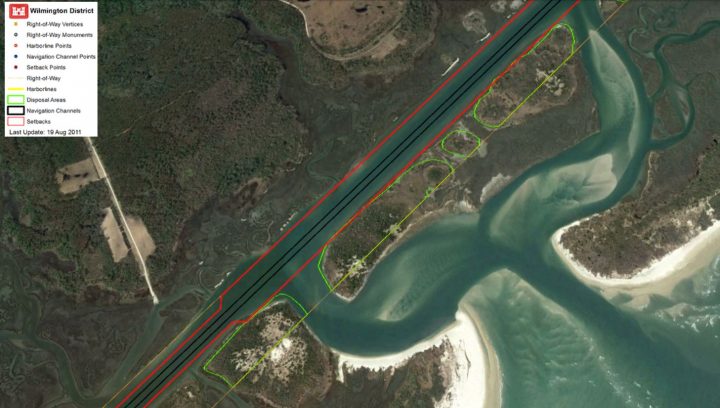
WILMINGTON – Keeping North Carolina’s more than 1,500 miles of federal navigation channels open for boating traffic takes planning, money and, as equally important, space to put sand pumped from clogged inlets and other coastal waterways.
A plan is in the works to determine how many nonfederally operated dredge material placement sites are along the state’s coast.
Supporter Spotlight
The North Carolina Division of Water Resources has drafted a plan to study dredge material placement facilities, or DMPFs, either owned, operated or managed by the state, local municipalities, private marinas, conservation groups and other nonfederal stakeholders.
The draft dredged material management plan, or DMMP, will identify those nonfederal disposal sites, determine the condition of and capacity of each facility, and evaluate the current dredging needs of nonfederal users including beach towns and private marinas.
If funded, the plan would consist of a second phase – a written report assessing disposal needs of nonfederal users over a 20-year period, identifying areas where new sites are needed and where those sites may be located.
Anywhere from 30 to 60 potential DMPFs are along the coast, based on the current information DWR has, division Assistant Director Coley Cordeiro said.
“We’re going to have to do focus groups in the various municipalities to better assess if there’s any privately owned or operated placement facilities that we’re not aware of currently,” she said.
Supporter Spotlight
The proposed study would be a significant step for future nonfederal dredging projects since the Army Corps of Engineers announced that only sand pumped from federal projects could be placed in Corps-maintained facilities.
The Corps’ February 2017 guidance was made to conserve space within its disposal sites after millions of cubic yards of material dredged from nonfederal projects were placed in a single DMPF in Galveston, Texas.
Since that decision, officials in the Corps’ Wilmington district have been consulting with the state and stakeholders about any possible alternatives.
The North Carolina Beach, Inlet and Waterway Association earlier this year initiated a plan to try and get the Corps to narrow its ban to deep-draft navigation projects, or those where a channel is maintained deeper than 16 feet.
This would allow North Carolina municipalities and small businesses the opportunity to dump dredge spoil pumped from shallow-draft projects, or those that are no more than 15 feet deep, onto federally managed disposal areas.
Seventeen of the state’s 19 navigable inlets are shallow-draft inlets, which tend to shoal more rapidly than deep-draft inlets and therefore require more frequent dredging to keep them unclogged and navigable.
Kathleen Riely, the association’s executive director, said in an email “it is a challenge but we are making some headway.”
“The Corps (both local and in DC) is very well aware of the issue we have here in (North Carolina) and is looking at giving the local districts more discretion in making decisions like these,” she said. “There is talk in DC, not only regarding the dredge disposal issue but other issues as well, that the local districts are in a better position to make these kinds of decisions. It is ongoing and as of now there is no definitive change in writing. We are following this issue.”
Whatever decisions the Corps makes will not affect the state’s plans to create a DMMP, Cordeiro said.
“As far as the dredge material management plan, we’re moving forward,” she said. “This is definitely the next step required regardless of the Corps’ decision.”
A draft of the plan has been sent out twice to stakeholders for their feedback.
Corderio said her deadline to get that feedback compiled and sent up for review by executive staff with the state Department of Environmental Quality was at the end of August. Corderio said Thursday that the revised draft that includes edits from the coastal communities and state agency employees was submitted Wednesday.
The draft plan will then be turned over to the Corps’ Wilmington district, which will review the plan, determine the estimated cost to do the study and send it back to the state before it goes to the Corps’ South Atlantic Division in Atlanta. The division will decide whether to fund half of the study through the Corps’ Planning Assistance to States Program.
Todd Horton, the Corps’ deputy chief of navigation, said the plan is to try and obtain funding for the study sometime next year.
The district office currently has permit applications for two non-federal dredge projects.
Horton said the office is in discussions with the applicants to possibly to allow them to use Corps-maintained disposal sites if those applicants agree to first remove material from those sites.
“There is talk in DC, not only regarding the dredge disposal issue but other issues as well, that the local districts are in a better position to make these kinds of decisions.”
Kathleen Riely, director, North Carolina Beach, Inlet and Waterway Association
In other words, the applicant would be responsible for removing at least as much material from the DMPF as would be placed in the site.
For example, if an applicant wants to dispose of 10,000 cubic yards of material, that applicant must first remove no less than 10,000 cubic yards of sand.
The applicants the Corps has been in discussion with would be the test pilots of such an agreement.
The Corps manages more than 200 DMPFs totaling more than 5,000 acres in North Carolina. Some of those sites have not been used, according to Corps’ officials. Other sites are nearly full.
Justin McCorcle, an attorney with the Corps’ Wilmington district, said the district office continues to ask about clarifications to the February 2017 guidance memorandum.
“We have been working with the state of North Carolina to help develop plans for local users to be able to essentially find locations where that material may be deposited,” he said. “Probably outside the federal disposal areas, but there may be adjacent properties that may be able to accept that material. There are limitations on what we could and couldn’t do there, but in terms of our ability to potentially help the state identify potential locations and prioritize them, that’s something that we might be able to do.”
He said the Corps’ assistance program typically funds projects under $200,000. The Corps is currently working with the state under one such project that received funding from the program to inventory privately owned dams and levees across the state.
“We continue to be willing and actively engaged in partnering with the state and we’re happy with the Division of Water Resources to work with us to find solutions,” McCorcle said. “There is the long-term opportunity for partnership agreements between the state and the Corps that could open up a variety of potential opportunities along the waterway.”








